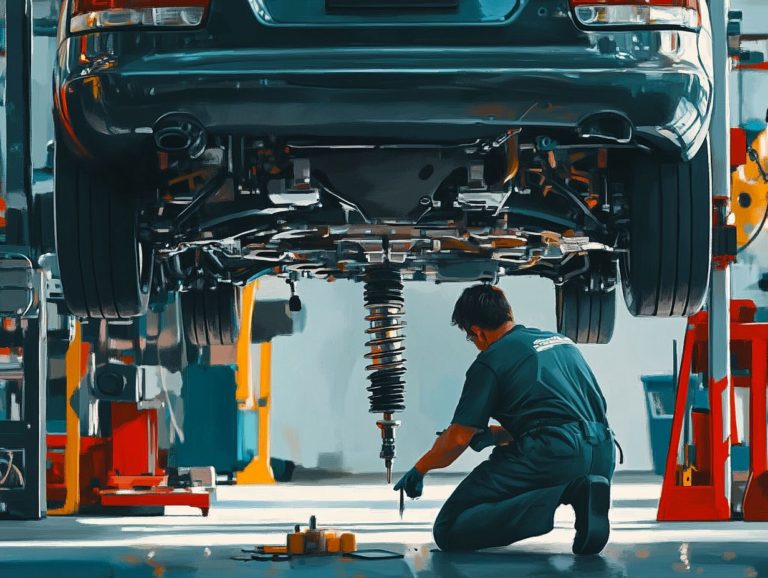How to Change Your Oil: A Step-by-Step Guide
Regular oil changes are vital for your vehicle’s smooth operation. They also help extend its lifespan.
This guide offers everything you need to change your oil. It includes necessary supplies, tools, and a clear step-by-step process.
You ll discover tips for a successful oil change. This guide will also highlight common pitfalls and help you know when to schedule your next oil change.
Follow this guide to keep your engine in great shape. A healthy engine ensures a reliable ride for years to come!
Contents
Key Takeaways:

- Regular oil changes are crucial for your vehicle’s health.
- You ll need basic tools, a new oil filter, and the right oil type.
- Follow steps carefully and check oil levels regularly to prevent damage.
Why Regular Oil Changes are Important
Regular oil changes are essential for keeping your vehicle’s engine in top shape. Fresh engine oil lubricates the internal components, reduces friction, and prevents overheating, all while enhancing fuel efficiency.
If you let old oil linger too long, it can become contaminated. This leads to increased wear and tear on crucial engine parts, which might ultimately shorten your vehicle’s lifespan.
By following the oil change intervals outlined in your owner’s manual, you ensure that your car operates s smoothly and reliably.
The frequency of your oil changes can vary based on several factors. These include the type of vehicle, the design of the engine, and your driving conditions.
For instance, high-performance vehicles or those often driven in extreme conditions may need more frequent servicing to maintain optimal engine health.
Regular oil changes also provide a valuable opportunity to catch potential issues like leaks or unusual wear early on, before they turn into costly repairs.
By prioritizing oil changes, you not only safeguard your engine’s performance but also promote better fuel efficiency.
This approach helps reduce your overall maintenance expenses and extends the life of your vehicle.
Supplies Needed for Oil Change
To successfully change your car s oil, gather several essential supplies that guarantee an efficient and safe oil change experience.
Start with a high-quality oil filter, which effectively captures contaminants.
Be sure to select fresh engine oil that aligns with the viscosity specifications outlined in your owner’s manual. An oil drain pan is also essential for collecting the old oil.
Don t overlook the importance of an oil capture container for proper disposal. This not only ensures you follow oil recycling guidelines but also keeps your vehicle safe throughout the entire process.
Tools and Materials
Proper tools and materials are essential for executing an efficient DIY oil change, ensuring both safety and effectiveness throughout the process.
A durable oil catch pan is a must-have in your vehicle maintenance toolkit. It collects used oil, preventing spills and protecting the environment.
Remember to keep a funnel handy; it makes pouring new oil a breeze and helps you avoid any messy mishaps.
Plus, don t underestimate the importance of safety equipment like gloves and safety glasses. They shield you from potential hazards, such as splashes from old oil.
Handling each tool with care significantly reduces the risk of accidents, making the entire procedure smoother and more enjoyable.
By following these best practices, you’ll enhance your DIY skills and cultivate a rewarding sense of accomplishment in maintaining your vehicle.
Step-by-Step Guide to Changing Your Oil
Changing your oil is a simple yet essential task that you can master with basic maintenance skills and the right tools at your disposal.
By following a clear, step-by-step guide, you ensure that the oil change is executed flawlessly, ultimately boosting your vehicle’s performance and extending its lifespan.
This process involves several key steps:
- Preparing your vehicle properly
- Draining the old oil
- Replacing the oil filter
- Adding fresh engine oil
Each of these steps plays a vital role in maintaining your engine’s lubrication system and ensuring your vehicle remains safe and reliable on the road.
Step 1: Prepare Your Vehicle

Before starting your oil change, it s essential to prepare your vehicle properly. This first step sets you up for success, ensuring safety and effectiveness throughout the process.
Secure your vehicle on a level surface. Use a hydraulic jack, a tool that lifts your vehicle, suitable for its weight to avoid any potential accidents. Positioning jack stands is essential; they protect you from unexpected drops.
As you don your safety glasses, consider adding gloves to shield your hands from hot or sharp parts. Once you re ready, use the oil dipstick for an accurate reading of your oil levels.
Familiarizing yourself with the oil filter and drain plug locations is important. This knowledge empowers you to execute the oil change efficiently, minimizing mishaps.
Step 2: Drain the Old Oil
Draining the old oil is a key step in the oil change process. This ensures that any contaminated oil is completely removed before introducing fresh oil.
Start by positioning an oil drain pan beneath the oil drain plug to catch the old oil as it flows out. Carefully unscrew the drain plug with a wrench and let the oil drain fully into the pan.
Once the oil has finished draining, replace the drain plug and ensure it s securely tightened. Follow proper disposal methods for the old oil; recycle it at a designated facility.
Take your time during this process to avoid spills don’t let spills ruin your job! After you ve removed the drain plug, let the oil sit for a moment to extract maximum contaminants.
When the old oil is fully collected in the drain pan, don t just toss it aside; take it to a recycling center where it can be processed properly. Many local automotive shops and waste management facilities provide recycling services for used oil.
Handling used oil properly meets environmental regulations and promotes a more eco-friendly approach to vehicle maintenance. This fosters sustainable practices essential for protecting our planet.
Step 3: Replace the Oil Filter
Replacing the oil filter is essential for maintaining optimal engine performance. It ensures that impurities don t contaminate your new oil and helps extend your engine’s life.
To start, locate the oil filter housing, usually found on the side of the engine block or beneath the vehicle. Using an oil filter wrench, carefully unscrew the old oil filter, ensuring you have an oil drain pan positioned below to catch any residual oil.
Pay attention to the orientation of the old filter, as it will guide you during the new installation. Before placing the new oil filter, apply a bit of fresh oil to the rubber gasket for an easier future removal and a snug seal, crucial for effective engine lubrication.
Once the filter is in place, tighten it securely, but don t overdo it too much force can damage the gasket.
Step 4: Add New Oil
After replacing the oil filter, it s essential to add new oil, which plays a crucial role in engine lubrication and overall performance. Start by selecting the right engine oil based on the viscosity, meaning the thickness of the oil, recommended in your owner’s manual.
Choose high-quality oil that meets industry standards; this choice can significantly influence your engine’s longevity. Once you’ve made your selection, grab a funnel and pour the oil carefully into the oil filler cap, keeping an eye on the quantity to avoid overfilling, which could lead to serious engine problems.
After adding the new oil, check the level using the dipstick. Pull it out, wipe it clean, and reinsert it to confirm that the oil sits within the marked range. Getting a proper reading is key to ensuring your engine runs efficiently and is protected from potential damage.
Tips for a Successful Oil Change
To achieve a seamless oil change, there are several effective strategies you can implement to enhance efficiency and avoid common pitfalls. Begin by assembling all necessary tools and supplies beforehand to streamline the process.
Double-check your oil levels both before and after the change to prevent overfilling or underfilling. Prioritizing safety precautions when lifting your vehicle is essential.
Familiarize yourself with the oil change techniques for your car model. Don’t hesitate to consult your owner s manual for further guidance.
Common Mistakes to Avoid

Avoiding common mistakes during an oil change is crucial for ensuring your vehicle’s health and longevity. One frequent misstep is neglecting to change the oil regularly, which can lead to engine wear and reduced performance.
Overlooking the location of the oil filter and improperly disposing of old oil can result in unsafe driving conditions and harm the environment.
Always ensure you have basic car repair knowledge and follow recommended oil change practices for an effective process.
Many underestimate the impact of stale or dirty oil on their engine. It’s essential to check your vehicle s manual for specific recommendations on oil change frequency, as different engines have varying needs.
Using the correct oil type is equally important; failing to do so can exacerbate issues, compromising efficiency and potentially damaging engine components.
Proper disposal techniques should not be overlooked. Utilize designated recycling centers to handle old oil responsibly, protecting both your vehicle and the planet.
By staying informed and vigilant, you can maintain your vehicle in optimal condition, promoting safety on the road.
Maintaining Your Vehicle’s Oil Levels
Maintaining your vehicle’s oil levels is essential for optimal engine lubrication and performance. This requires regular checks and a commitment to oil change intervals.
Monitoring oil levels helps you spot any leaks or drops in volume, which could signal underlying issues. Recognizing signs that indicate your oil needs changing like unusual engine noises or a change in oil color can save you from long-term damage and costly repairs.
How Often to Change Your Oil
Determining how often to change your oil is vital for engine lubrication and ensuring your vehicle performs at its best. Most manufacturers provide guidelines based on driving conditions, recommending oil changes every 3,000 to 7,500 miles, depending on the type of engine oil you use.
Change your oil regularly, especially if you frequently drive in harsh conditions, as this may require more frequent changes to keep your engine running smoothly.
Consider factors like frequent short trips, stop-and-go traffic, and towing heavy loads. These can increase strain on your engine and accelerate oil breakdown.
You might also find that synthetic oils allow for longer intervals between changes compared to conventional options, giving you more flexibility.
While it’s important to follow the manufacturer s schedule, don t overlook your personal driving habits, climate conditions, and the age of your vehicle. By closely monitoring these elements, you can make informed choices to enhance your engine’s health and longevity.
Start your oil change today and give your engine the care it deserves!
Signs Your Oil Needs to be Changed
Recognizing the signs that your oil needs changing is essential for keeping your engine running longer and ensuring it operates at peak performance. Keep an eye out for common indicators like a drop in oil levels, a gritty texture when you check it with the dipstick, or that dark, murky appearance of the oil itself.
If you hear any unusual engine noises or see the oil change light flicker to life on your dashboard, don’t wait act quickly! Follow proper oil change steps to prevent potential engine damage.
These signs mean it’s time for an oil change and highlight the importance of being proactive with your regular maintenance. By checking oil levels frequently and conducting visual inspections, you can catch problems early, potentially dodging more severe issues down the road.
Ignoring these indicators can lead to a decline in engine efficiency and longevity, ultimately resulting in costly repairs. Regular oil changes ensure your engine remains well-lubricated, contribute to better fuel efficiency, and provide a smoother driving experience. Staying attentive to these warning signs is not just wise; it’s super important!
Frequently Asked Questions
What tools do I need to change my oil?

To change your oil, you will need a wrench, oil filter wrench, oil drain pan, funnel, new oil filter, and new oil. Gloves and rags are helpful for clean-up.
How often should I change my oil?
It is recommended to change your oil every 3,000 to 5,000 miles or every 3 to 6 months, whichever comes first. However, check your vehicle’s manual for the manufacturer’s specific recommendation.
Can I change my oil without lifting my car?
Yes, you can change your oil without lifting your car by using ramps or a jack with jack stands, which help raise the car safely. Always make sure to follow proper safety precautions when working underneath your vehicle.
How do I know which oil to use?
Check your vehicle’s manual for the recommended type and thickness of oil for your specific make and model. You can also find this information online or ask a professional at an auto parts store.
Can I recycle my used oil?
Yes, used oil can and should be recycled. Many auto parts stores and recycling centers accept used oil for proper disposal. Never pour used oil down the drain or into the environment.
Do I need to change my oil filter every time I change my oil?
Yes, it is recommended to change your oil filter every time you change your oil. Old oil filters can become clogged and decrease the effectiveness of your new oil, leading to potential engine damage.






